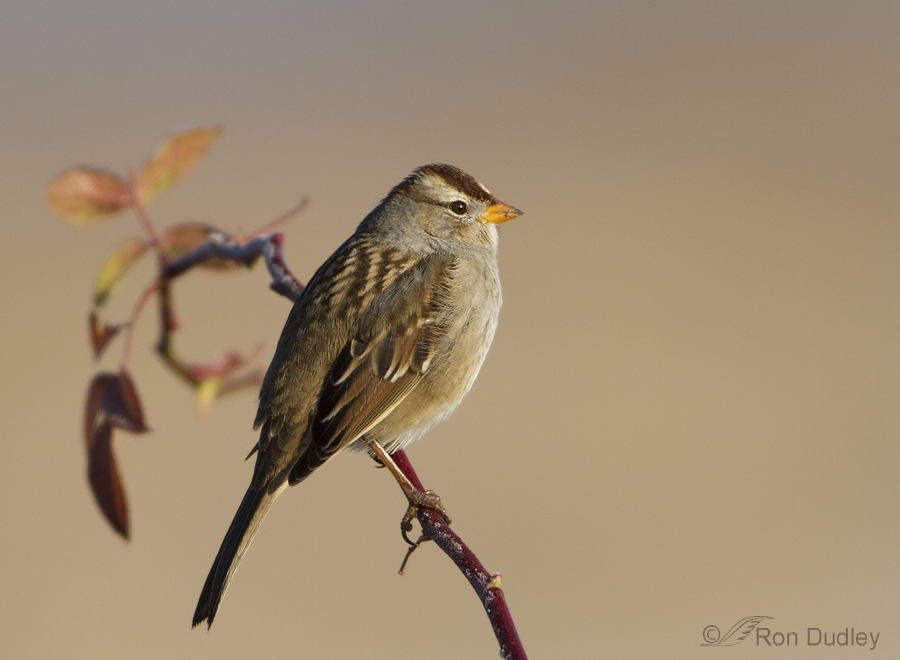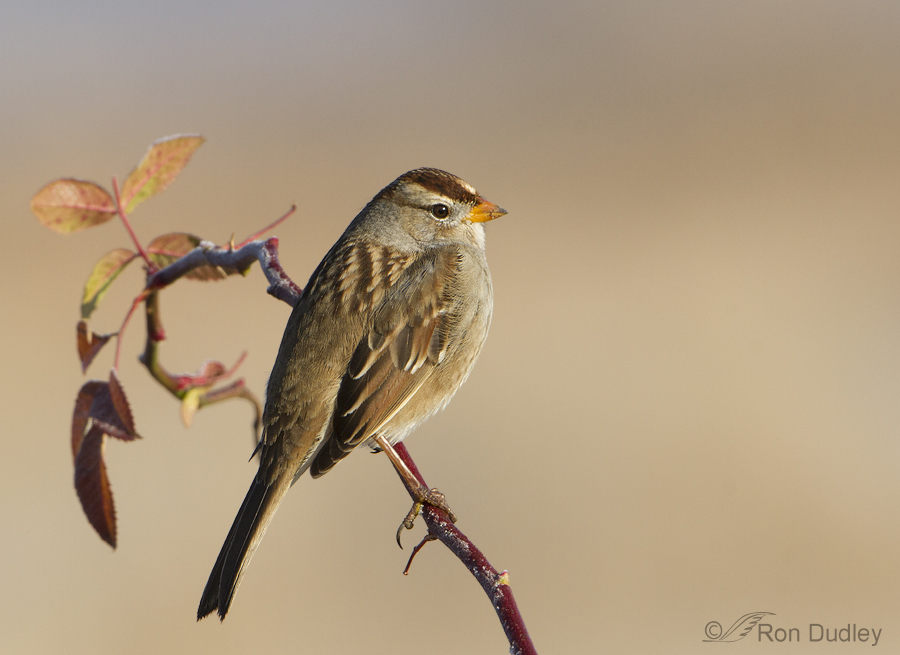Two days ago I found this juvenile White-crowned Sparrow sunning itself in a wild rose-bush at Farmington Bay. It was a cold morning (you can see frost on the perch behind the bird) and due to the frigid temperature the sparrow wasn’t flitting around much so I did a little experimentation with depth of field.
1/2000. f/5.6, ISO 500 500 f/4, 1.4 tc, natural light, not baited, set up or called in
As I looked at the bird through the viewfinder I wondered if the rose leaves in the background would look best as sharp as I could get them or as out of focus as possible. I knew they were in an intermediate position where I wouldn’t be able to get them either tack sharp or completely soft and featureless but I had a cooperative bird so I decided to play with my options and see what I liked best.
With my gear (including attached tc) the narrowest depth of field I can get is at f/5.6. which makes sharpness fall away fast behind the sparrow. Since the bird is turned sideways to me even the tail is in the same plane as the rest of the body and is sharp. The background leaves are quite soft which helps to focus attention on the sharp bird.
If I’d removed my tc, the effect of a shorter focal length and being able to shoot at f/4 instead of f/5.6 would have rendered the leaves even more out of focus but the sparrow would have been smaller in the frame and had less detail.
1/320. f/13, ISO 500 500 f/4, 1.4 tc, natural light, not baited, set up or called in
So I decided to see how much depth of field I could get at f/13. As you can see by comparing the two images it made a significant difference in the sharpness of the background leaves but they’re still far from tack sharp. I could have gone to something like f/16 for even more background sharpness but that would have destroyed my shutter speed – notice that it’s already dropped from 1/2000 to 1/320 with this change in aperture (I shoot in aperture priority).
I suppose which effect one prefers is a matter of taste (if it matters much at all). Personally in this instance I prefer the DOF in the second image. I also prefer the bird in the second shot because of slightly better light on the back of the sparrow and a bit more of a head turn that provides better eye contact.
Sorry about the “photo-geekiness” of this post. When I begin composing a new post I never really know where I’ll end up and this time it turned out to be photography technique which will likely have more appeal for some than it will for others.
I hope each and every one of you has a wonderful (and safe) Thanksgiving with family and friends and that the holiday season provides you with many fond memories that will last a lifetime.
As for me, I’m hoping to photograph some birds this morning before I eat one later in the day…
Ron




Happy Thanksgiving.
Love the lbj – and join the majority in preferring the second image.
F/13 is definitely much better. When I shot birds, I stayed with f/13 with the 100-400mm lens, precisely because of this situation. But for you it’s just more difficult because birds move. For me it’s easier because now I’m photographing Flora, and they sure don’t move, except with the wind! It’s kind of a similar situation, but my situation is perhaps more predictable. The wind is #1 enemy for shooting flora. Great lesson!
What I was referring to was using f/13 with the 100-400mm Canon lens to maximize its IQ. This lens is definitely soft at 400mm. It cannot compare with your 500mm. Yet I would have to stop it down even more (in this example with a bird), and I would miss the shot.
I also like the second photo, as Alison stated ,the repeating patterns in the leaves tie nicely together with not only the beak of the sparrow ,but also the leaf on the top left also repeats the shape of the sparrow’s head ( at least to me anyway…) .Happy and Healthy Thanksgiving Ron and Mia ( and everyone )!!
I’m waffling between the two images…not with the composition, though. It couldn’t be better…
Ilike both images…maybes the second slightly more…particularly like the subject…these little guys are so tame and cute.
Although the bird is sharp in the first photo, like Susan, my eye is drawn (uncomfortably) to the blurry leaves. I find them very distracting … Not blurry enough, I guess. So I much prefer the see come, too.
I am also more drawn to the second photo. Part of the reason is that my eyes keep trying to bring the blurry leaves into focus, so in the first photo they are more distracting. In the second photo, also, it seems like the bird is looking at you instead of staring straight ahead while posing for a portrait, and that adds to the draw.
Happy Thanksgiving to you and yours.
Happy Turkey Day from central MT Ron! I like shot #2 as well for the improved lighting.
I too like the second image better Ron.I think it has a more natural feel to it….less a photograph and more like you would see the bird live in person in the field.None the less they are both great photos. Happy Thanksgiving!
Happy Thanaksgiving Ron. I like the bird better in photo 2. But I actually really like the first photo. My attention immediatley went to the bird. The second photo, my eyes ahd to take in everything at once. The bird pose in the second shot is great. Always a fun learning experience. Don’t eat too much turkey!! If I took pictures of turkeys, I wouldn’t be able to eat them!!! lol
Yup, another vote for the second. I think my brain couldn’t accept the fuzziness of the leaves in the first. “What’s that sharp bird doing sitting on that fuzzy glob?” The background actually detracted from the bird. Second much more satisfying.
That little brown job is revealed to be a lovely arrangement of patterns, with every perfect feather in place. I’m giving thanks for the sharpened vision of the world that you give us so generously. Thank you, Ron!
Alison, Kathy and Kelly – I too prefer the second image but I wish the pose and light on the bird were exactly the same so I could be sure about WHY I have that preference. That said, I’m pretty confident that in this case I like the sharpness of the leaves best in the second image.
I too prefer the second photo, shot in settings I’m familiar with. I shoot in manual and am always jiggering the numbers. Wish I could jigger one of those beautiful backgrounds of yours. Lovely lovely photo. To you and yours, a Happy Thanksgiving!
Happy Thanksgiving from central MT Ron! Supposed to be 50 degrees here today & I’m lovin’ it! I like your second shot also for the improved lighting. Hope your day is a “full” one.
Ron
I’m not a photographer but an artist. I love how the second picture picks up the color of the bird’s beak in the back of the leaves.. It’s by far my favorite picture of the two. Thank you so much for your posts–for a novice birder and photographer I have learned so much. Mostly I just appreciate the beautiful images.
It’s interesting – I found myself much more drawn to the second photo, so maybe the ‘photo-geekiness’ serves a good purpose. My response was completely automatic – I ‘perked up’ considerably upon seeing the latter image. I’m guessing that my brain instantly logged a pattern between the orange leaf that extended the farthest to the right and the beak, once the shape of the leaf was more clearly delineated.
I’ll be interested to see if others gravitate automatically to one image more than the other…
Happy Thanksgiving to you!